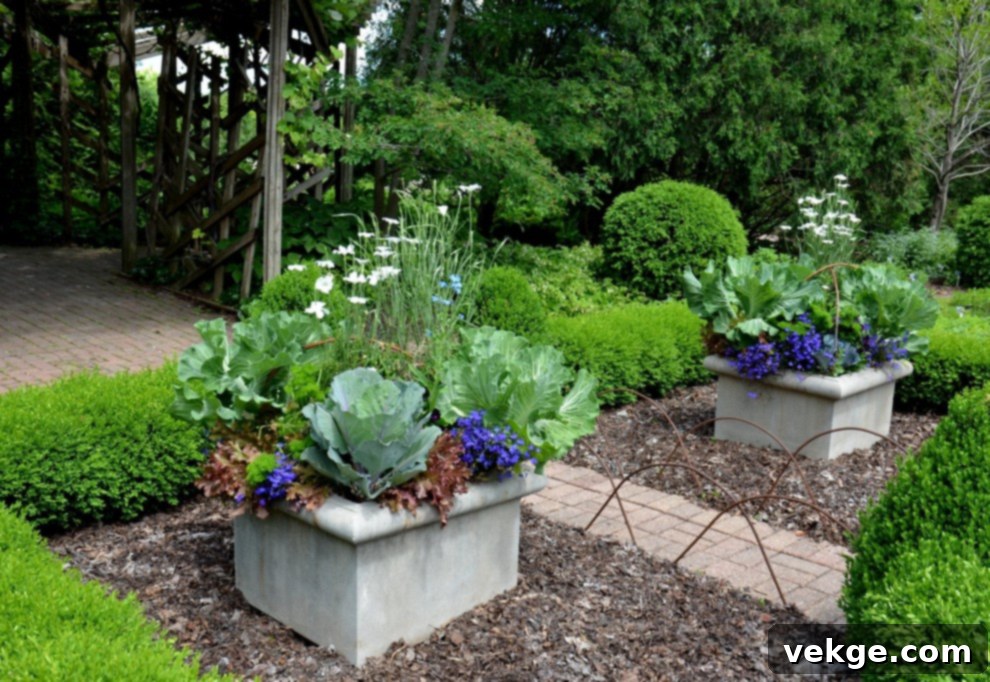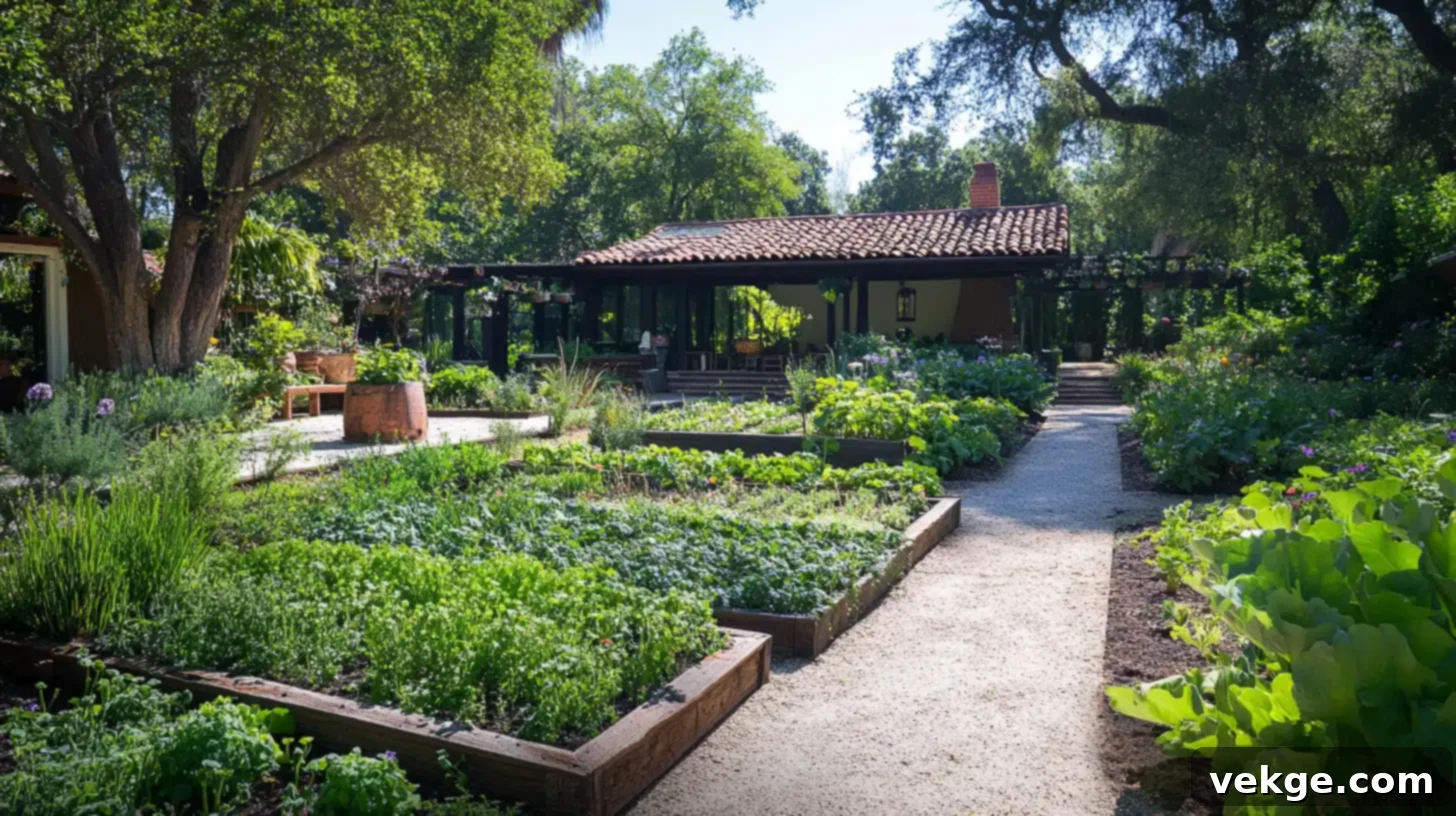Edible Landscaping: Design a Beautiful & Bountiful Garden Oasis
Imagine stepping into your garden, not just to admire its beauty, but also to gather fresh, organic ingredients for your next meal. This dream is the essence of edible landscaping – a revolutionary approach to garden design that seamlessly blends aesthetic appeal with practical functionality. It’s about transforming your outdoor space into a vibrant, living pantry where every plant, from decorative herbs to colourful vegetables and fruit-bearing trees, serves a dual purpose: to enchant your eyes and nourish your body. This innovative gardening style turns traditional garden plots into a cohesive work of art, offering a steady, delicious supply of homegrown food right at your fingertips.
Beyond the immediate gratification of fresh produce, edible landscaping fosters a deeper connection with nature, promotes sustainable living, and often reduces your grocery bill. It’s a journey into creating a truly dynamic and rewarding outdoor environment. Here’s how you can embark on this exciting path, choosing edible plants that offer both stunning visual appeal and invaluable culinary benefits, making your garden a true oasis of beauty and bounty.
Choosing Dual-Purpose Plants: Beauty and Bounty in One

One of the most exciting aspects of edible landscaping is the vast array of plants that excel in both visual charm and culinary usefulness. Many herbs and vegetables are just as visually appealing as they are practical, offering unique colours, textures, and forms that can elevate any garden design. Consider the dramatic flair of rainbow chard or purple kale; their deep reds, vibrant purples, and bright greens bring bold contrast and texture, making them perfect for adding striking visual interest to your landscape beds or even container arrangements.
Beyond leafy greens, many other edible plants contribute significantly to garden aesthetics. Artichokes, with their large, silvery-green leaves and impressive thistle-like flowers, add a Mediterranean, architectural quality to any space. Ornamental peppers provide a burst of colour with their brightly hued fruits, while flowering herbs like chives or borage offer delicate blooms that attract pollinators and add a soft touch to your design. Furthermore, herbs such as lavender, with its beautiful purple spikes and calming fragrance, is a versatile plant used in cooking and home remedies. Robust herb seeds like rosemary, thyme, and oregano can be planted along borders or pathways, creating soft, fragrant edges that are not only beautiful but also provide a steady supply of flavorful additions to your dishes year-round. These choices prove that a functional garden doesn’t have to sacrifice an ounce of beauty.
Elevate Your Garden: Creative Vertical Edible Solutions
For gardeners working with limited space, or simply looking to add a unique dimension, vertical gardening is an ideal solution for incorporating more edible plants into your landscape. Utilizing vertical elements allows you to grow more in less square footage, turning plain walls, fences, or even narrow pathways into lush, productive areas. Climbing vegetables like beans, peas, and various tomato varieties (especially vining types) can be trained to grow on elegant trellises, sturdy arbours, or even custom-built pergolas, transforming simple structures into stunning green focal points laden with delicious produce.
Beyond traditional climbers, consider innovative vertical planters, tiered garden boxes, or hanging baskets. These are perfect for cascading herbs like mint, thyme, and oregano, which will spill over the edges, adding layers of greenery and fragrance. Strawberries also thrive in vertical towers, offering easy harvesting and a beautiful display of berries. Not only do vertical elements enhance the visual appeal of your garden by creating dynamic height and depth, but they also offer practical benefits such as improving air circulation around plants, reducing common soil-borne diseases, making harvesting easier on your back, and helping you maximise every inch of your available space. This smart design strategy ensures your garden remains both beautiful and highly productive.
Ground Cover and Borders: Edibles That Define Your Space
Ground cover plants are an often-underestimated component of a well-designed garden, crucial for moisture retention, weed suppression, and visual cohesion. By choosing edible options, you can make them work double duty, adding both beauty and harvestable bounty. Low-growing herbs such as creeping thyme, wild strawberries, or oregano are perfect for filling in spaces between stepping stones, as a fragrant alternative to grass in small patches, or even as a living mulch under larger plants. Not only do these plants offer beautiful green coverage and suppress weeds, but they also release their lovely fragrance when gently brushed or stepped on, making every stroll through your garden a delightful sensory experience.
For defining borders and edges, consider using compact, vibrant edible plants. Varieties of lettuce, colourful kale, spinach, or even perennial alpine strawberries can create neat, attractive borders. These plants grow quickly, add vibrant colours and interesting textures to your landscape, and provide fresh produce throughout the growing season. Chamomile, with its delicate daisy-like flowers, can also form a lovely, fragrant, and edible border. Integrating these edible ground covers and border plants not only enhances the aesthetic appeal of your garden by creating defined lines and textures but also contributes to the overall health and productivity of your edible landscape, keeping the soil cool and moist while offering up a continuous harvest.
Designing with Purpose: Planting Patterns for Visual Harmony
A truly successful edible landscape isn’t solely about functionality; it’s also about creating a visually striking layout that pleases the eye and invites exploration. You can achieve this by consciously planting in patterns, incorporating diverse textures, and thoughtfully playing with colour contrasts. Think of your garden as a living canvas where you are the artist, arranging plants to create compelling compositions. For example, alternating rows or blocks of deep purple cabbage with bright green spinach or vibrant red lettuce can create a stunning checkerboard effect or a dynamic striped pattern that draws the eye.
Beyond straight lines, consider planting herbs like basil, parsley, sage, or even small annual vegetables in geometric shapes, spirals, or concentric circles. This creates a sense of organisation and intentional design, transforming simple planting beds into intricate works of art that are still highly functional. Varying plant heights and forms also adds depth and interest; combine bushy basil with upright rosemary and sprawling thyme. Pair these structured plantings with flowering herbs like chives, dill, or borage. Their delicate blooms not only add a burst of complementary colour but also play a vital role in attracting beneficial pollinators, further enhancing the health and productivity of your edible garden design. Strategic planting patterns elevate your garden from a mere food source to a captivating outdoor living space.
The Dynamic Duo: Blending Perennials and Annuals for Year-Round Appeal
To create a dynamic, resilient, and long-lasting edible landscape, it’s essential to thoughtfully mix perennial herbs and vegetables with annual varieties. Perennials form the enduring backbone of your garden. Plants such as rosemary, thyme, sage, mint, asparagus, rhubarb, fruit trees, and berry bushes will return year after year, offering both stability and structural elements to your garden’s design. These hardy plants are excellent for establishing permanent features like hedges, foundational borders, or long-term productive beds, providing consistent harvests without the need for yearly replanting.
Annuals, on the other hand, bring exciting variety and seasonal change. Crops like lettuce, spinach, basil, cilantro, tomatoes, peppers, and many vegetable seeds complete their life cycle in one season. This allows you the flexibility to refresh and reimagine portions of your garden space regularly, experimenting with new varieties and crops to ensure it remains vibrant, exciting, and full of life. By strategically combining perennials, which offer a consistent framework, with annuals, which provide seasonal flair and diverse harvests, you’ll enjoy an edible garden oasis that evolves beautifully through the seasons. This blend ensures a continuous supply of fresh produce and a perpetually interesting landscape, offering something new every time you step outside.
A Touch of Elegance: Incorporating Edible Flowers
For an extra layer of beauty and functionality, consider generously incorporating edible flowers into your landscape. These floral gems not only add a delightful pop of colour and elegance but also serve as unique, flavourful additions to your kitchen. Flowers like nasturtiums, pansies, violas, calendula, and borage are all wonderfully edible, bringing a sophisticated touch to your culinary creations. They can be used to garnish vibrant salads, infuse delicate oils and vinegars, decorate desserts, or simply add a stunning visual element to your plates, transforming everyday meals into gourmet experiences.
Beyond their aesthetic and gastronomic appeal, these flowers also play a crucial functional role in your garden’s ecosystem. Their colourful blooms are magnets for beneficial insects and essential pollinators such as bees and butterflies, which are vital for the successful fruit set and increased yield of your other fruit-bearing and vegetable plants. This dual purpose – adding undeniable beauty while actively supporting your garden’s health and productivity – makes edible flowers an absolutely essential component of a thriving and visually appealing edible landscape design. They truly embody the harmonious blend of form and function.
Smart Design for Simple Care: Creating Edible Zones
When meticulously designing your edible landscape, it’s absolutely essential to think ahead about maintenance and ease of access. A well-planned garden is a joy to tend, while a haphazard one can quickly become overwhelming. A highly effective strategy for simplifying garden care is to create distinct zones, grouping plants with similar watering, sunlight, and soil needs together. This “zoning” ensures that each plant receives exactly what it requires to flourish, while also making your garden far more manageable and efficient.
For instance, sun-loving herb seeds like oregano, basil, rosemary, and thyme will thrive when planted together in a sunny, well-drained area close to your kitchen for convenient harvesting. Conversely, vegetables that prefer partial shade and more consistent moisture, such as lettuce, spinach, and Swiss chard, can be grouped in a different, cooler zone. Consider accessibility too: place frequently harvested items like salad greens and culinary herbs in beds closest to your home, while less-frequented crops like potatoes or winter squash can be located further afield. By creating these distinct zones for different plant types, you’ll make caring for your garden much simpler, conserve water and resources, and ensure each plant gets exactly what it needs to produce an abundant, healthy harvest. This intelligent design reduces effort and maximizes output, truly embodying the efficiency of an edible garden oasis.
The Ultimate Reward: Harvesting Your Beautiful, Bountiful Garden
The greatest and most satisfying reward of cultivating an edible landscape is undoubtedly the bountiful harvest it provides. Imagine the unparalleled pleasure of stepping outside and plucking vibrant, fresh herbs, crisp vegetables, and succulent fruits straight from your own garden for a homemade meal. This direct connection to your food source offers immense satisfaction and a profound sense of self-sufficiency. Whether you’re gathering fragrant basil for a fresh pesto, crisp leafy greens for a vibrant salad, or ripe tomatoes for a delicious sauce, your edible landscape will swiftly become a vital, cherished part of your daily life and culinary adventures.
By actively growing your own vegetable seeds and herb seeds, you gain complete control over the quality and freshness of your produce, ensuring it’s organic, free from harmful chemicals, and packed with unparalleled flavour and nutrition. The taste of homegrown food, picked at its peak, simply cannot be matched by anything from a grocery store. With thoughtful design, strategic plant selection, and a touch of dedication, you can create a garden that is not only stunningly gorgeous but also incredibly functional, offering endless delicious rewards. An edible landscape beautifully blends the best of both worlds, transforming your backyard into a thriving, sustainable, and eye-catching space that brings immeasurable joy to your table and enhances the beauty of your view. Embrace this enriching journey and enjoy the fruits (and vegetables!) of your labour. Happy planting!
